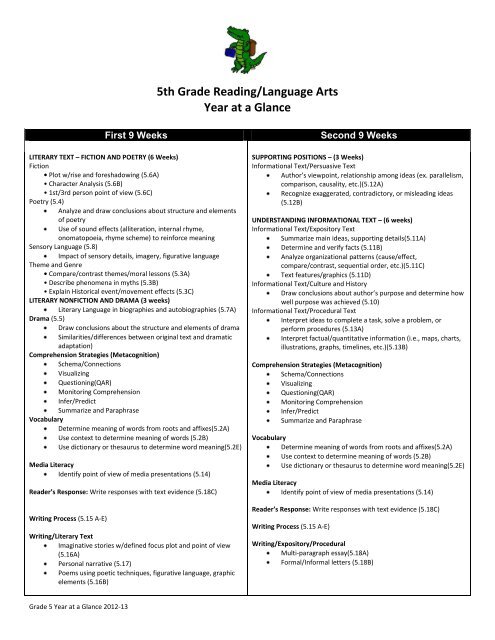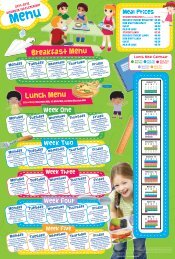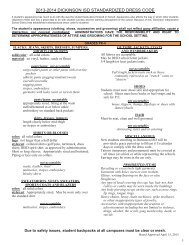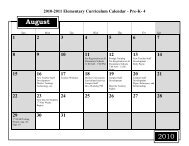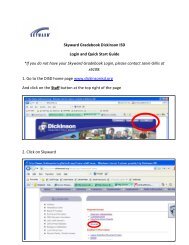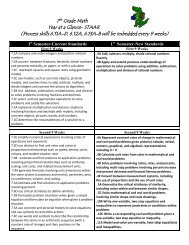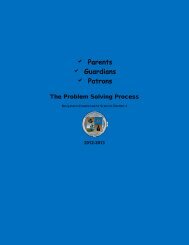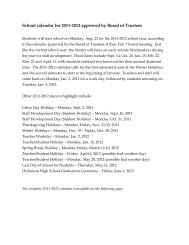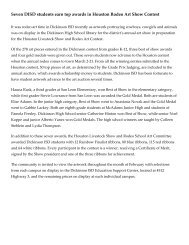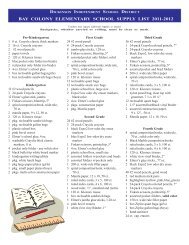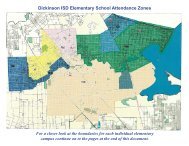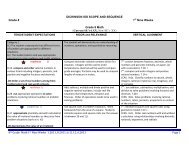5th Grade Reading/Language Arts Year at a Glance - Dickinson ISD
5th Grade Reading/Language Arts Year at a Glance - Dickinson ISD
5th Grade Reading/Language Arts Year at a Glance - Dickinson ISD
- No tags were found...
You also want an ePaper? Increase the reach of your titles
YUMPU automatically turns print PDFs into web optimized ePapers that Google loves.
<strong>5th</strong> <strong>Grade</strong> <strong>Reading</strong>/<strong>Language</strong> <strong>Arts</strong><strong>Year</strong> <strong>at</strong> a <strong>Glance</strong>First 9 WeeksLITERARY TEXT – FICTION AND POETRY (6 Weeks)Fiction• Plot w/rise and foreshadowing (5.6A)• Character Analysis (5.6B)• 1st/3rd person point of view (5.6C)Poetry (5.4)Analyze and draw conclusions about structure and elementsof poetryUse of sound effects (alliter<strong>at</strong>ion, internal rhyme,onom<strong>at</strong>opoeia, rhyme scheme) to reinforce meaningSensory <strong>Language</strong> (5.8)Impact of sensory details, imagery, figur<strong>at</strong>ive languageTheme and Genre• Compare/contrast themes/moral lessons (5.3A)• Describe phenomena in myths (5.3B)• Explain Historical event/movement effects (5.3C)LITERARY NONFICTION AND DRAMA (3 weeks)Literary <strong>Language</strong> in biographies and autobiographies (5.7A)Drama (5.5)Draw conclusions about the structure and elements of dramaSimilarities/differences between original text and dram<strong>at</strong>icadapt<strong>at</strong>ion)Comprehension Str<strong>at</strong>egies (Metacognition)Schema/ConnectionsVisualizingQuestioning(QAR)Monitoring ComprehensionInfer/PredictSummarize and ParaphraseVocabularyDetermine meaning of words from roots and affixes(5.2A)Use context to determine meaning of words (5.2B)Use dictionary or thesaurus to determine word meaning(5.2E)Media LiteracyIdentify point of view of media present<strong>at</strong>ions (5.14)Reader’s Response: Write responses with text evidence (5.18C)Writing Process (5.15 A‐E)Writing/Literary TextImagin<strong>at</strong>ive stories w/defined focus plot and point of view(5.16A)Personal narr<strong>at</strong>ive (5.17)Poems using poetic techniques, figur<strong>at</strong>ive language, graphicelements (5.16B)Second 9 WeeksSUPPORTING POSITIONS – (3 Weeks)Inform<strong>at</strong>ional Text/Persuasive TextAuthor’s viewpoint, rel<strong>at</strong>ionship among ideas (ex. parallelism,comparison, causality, etc.)(5.12A)Recognize exagger<strong>at</strong>ed, contradictory, or misleading ideas(5.12B)UNDERSTANDING INFORMATIONAL TEXT – (6 weeks)Inform<strong>at</strong>ional Text/Expository TextSummarize main ideas, supporting details(5.11A)Determine and verify facts (5.11B)Analyze organiz<strong>at</strong>ional p<strong>at</strong>terns (cause/effect,compare/contrast, sequential order, etc.)(5.11C)Text fe<strong>at</strong>ures/graphics (5.11D)Inform<strong>at</strong>ional Text/Culture and HistoryDraw conclusions about author’s purpose and determine howwell purpose was achieved (5.10)Inform<strong>at</strong>ional Text/Procedural TextInterpret ideas to complete a task, solve a problem, orperform procedures (5.13A)Interpret factual/quantit<strong>at</strong>ive inform<strong>at</strong>ion (i.e., maps, charts,illustr<strong>at</strong>ions, graphs, timelines, etc.)(5.13B)Comprehension Str<strong>at</strong>egies (Metacognition)Schema/ConnectionsVisualizingQuestioning(QAR)Monitoring ComprehensionInfer/PredictSummarize and ParaphraseVocabularyDetermine meaning of words from roots and affixes(5.2A)Use context to determine meaning of words (5.2B)Use dictionary or thesaurus to determine word meaning(5.2E)Media LiteracyIdentify point of view of media present<strong>at</strong>ions (5.14)Reader’s Response: Write responses with text evidence (5.18C)Writing Process (5.15 A‐E)Writing/Expository/ProceduralMulti‐paragraph essay(5.18A)Formal/Informal letters (5.18B)<strong>Grade</strong> 5 <strong>Year</strong> <strong>at</strong> a <strong>Glance</strong> 2012-13
Third 9 WeeksMAKING CONNECTIONS ACROSS LITERARY GENRES (3 weeks)Fiction• Plot w/rise and foreshadowing (5.6A)• Character Analysis (5.6B)• 1st/3rd person point of view (5.6C)Poetry (5.4)Analyze and draw conclusions about structure and elementsof poetryUse of sound effects (alliter<strong>at</strong>ion, internal rhyme,onom<strong>at</strong>opoeia, rhyme scheme) to reinforce meaningSensory <strong>Language</strong>Impact of sensory details, imagery, figur<strong>at</strong>ive language(5.8)Theme and Genre• Compare/contrast themes/moral lessons (5.3A)Literary NonfictionLiterary <strong>Language</strong> in biographies and autobiographies (5.7A)Drama (5.5)Draw conclusions about the structure and elements of dramaMAKING CONNECTIONS ACROSS INFORMATIONAL GENRES(3 weeks)Inform<strong>at</strong>ional Text/Expository TextSummarize main ideas, supporting details(5.11A)Determine and verify facts (5.11B)Analyze organiz<strong>at</strong>ional p<strong>at</strong>terns (cause/effect,compare/contrast, sequential order, etc.)(5.11C)Text fe<strong>at</strong>ures/graphics (5.11D)Inform<strong>at</strong>ional Text/Culture and HistoryDraw conclusions about author’s purpose and determine howwell purpose was achieved (5.10)Inform<strong>at</strong>ional Text/Procedural TextInterpret ideas to complete a task, solve a problem, orperform procedures (5.13A)Interpret factual/quantit<strong>at</strong>ive inform<strong>at</strong>ion (i.e., maps, charts,illustr<strong>at</strong>ions, graphs, timelines, etc.)(5.13B)Inform<strong>at</strong>ional Text/Persuasive TextAuthor’s viewpoint, rel<strong>at</strong>ionship among ideasMAKING CONNECTIONS ACROSS ALL GENRES (3 weeks)See all SE’s listed aboveComprehension Str<strong>at</strong>egies (Metacognition)Schema/ConnectionsVisualizingQuestioning(QAR)Monitoring ComprehensionInfer/PredictSummarize and ParaphraseVocabularyDetermine meaning of words from roots and affixes(5.2A)Use context to determine meaning of words (5.2B)Use dictionary or thesaurus to determine word meaning(5.2E)Media LiteracyIdentify point of view of media present<strong>at</strong>ions (5.14C)Reader’s Response: Write responses with text evidence (5.18C)Writing Process (5.15 A‐E)Writing/Literary TextImagin<strong>at</strong>ive stories w/defined focus plot and point of view(5.16A)Personal narr<strong>at</strong>ive (5.17)Fourth 9 WeeksUNDERSTANDING THE RESEARCH PROCESS – (3 weeks)Research:• Topic, open‐ended questions (5.23A)• Research plan (5.23B, 5.24A)• Primary/Secondary Sources (5.24B)• D<strong>at</strong>a (5.24C)• Source of notes (5.24D)• Paraphrasing/Plagiarism, Valid Sources (5.24E)• Refine questions (5.25A)• Evalu<strong>at</strong>e relevance, validity and reliability of sources (5.25B)Organizing and Presenting:• Multiple source inform<strong>at</strong>ion (5.26A)• Topic sentence, summarize, evidence (5.26B)• Presenting findings (5.26C)• Acknowledge sources (5.26D)Inform<strong>at</strong>ional Text/Expository TextSummarize main ideas, supporting details(5.11A)Determine and verify facts (5.11B)Analyze organiz<strong>at</strong>ional p<strong>at</strong>terns (cause/effect,compare/contrast, sequential order, etc.)(5.11C)Text fe<strong>at</strong>ures/graphics (5.11D)Synthesize and make logical connections betweenideas(5.11E)Inform<strong>at</strong>ional Text/Culture and HistoryDraw conclusions about author’s purpose and determine howwell purpose was achieved (5.10)MEDIA IMPACT – (6 weeks)Media LiteracyExplain how messages conveyed are presented differently invarious forms of media (5.14A)Difference in Techniques (5.14B)Identify point of view of media present<strong>at</strong>ions (5.14C)Analyze digital media for formality and Informality(5.14D)Comprehension Str<strong>at</strong>egies (Metacognition)Schema/ConnectionsVisualizingQuestioning(QAR)Monitoring ComprehensionInfer/PredictSummarize and ParaphraseVocabularyDetermine meaning of words from roots and affixes(5.2A)Use context to determine meaning of words (5.2B)Use dictionary or thesaurus to determine word meaning(5.2E)Reader’s Response: Write responses with text evidence(5.18C)Review Writing Process (5.15 A‐E)Expository/Procedural• Multi‐paragraph essay(5.18A)• Formal/Informal letters (5.18B)• Summary/logical order (5.11A)• Organiz<strong>at</strong>ional p<strong>at</strong>terns (5.11C)• Text fe<strong>at</strong>ures/graphics (5.11D)Persuasive: Essay th<strong>at</strong> includes sound reasoning, detailed and relevantevidence, and consider<strong>at</strong>ion of altern<strong>at</strong>ives (5.19)<strong>Grade</strong> 5 <strong>Year</strong> <strong>at</strong> a <strong>Glance</strong> 2012-13


